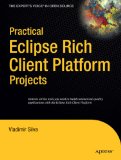 There aren’t many books available about the Eclipse Rich Client Platform. One reason for this, I think, is that it’s a difficult subject to cover effectively. Eclipse RCP is less a coherent framework than an aggregation of related technologies, and this can make it difficult to describe. As someone who has worked hard to craft clear Eclipse RCP training materials over the last few years, I sympathize with anyone who takes up the challenge.
There aren’t many books available about the Eclipse Rich Client Platform. One reason for this, I think, is that it’s a difficult subject to cover effectively. Eclipse RCP is less a coherent framework than an aggregation of related technologies, and this can make it difficult to describe. As someone who has worked hard to craft clear Eclipse RCP training materials over the last few years, I sympathize with anyone who takes up the challenge.
And taking up this challenge is Vladimir Silva in his book Practical Eclipse Rich Client Platform Projects. I hadn’t heard much about this book, and only found about it when browsing the book table at last year’s EclipseCon. This summer I’ve finally found the time to read it and here is my review.
A good start
The first thing I like about the book is that it’s short. At a mere 335 pages, the book invites you to actually read it, not just treat it as reference material. I have a bias towards shorter technical books in general, as it shows a bit of self-discipline and thoughtfulness. The books produced by Pragmatic Programmers are a great example of this.
I also like the way the book starts, with a focus on OSGi. It’s essential that RCP developers learn from the start that OSGi and modularity are at the heart of the platform. Everything seems to click faster for developers when they understand some OSGi basics.
A strange mix
So far so good, but what is the rest of the book like? The word I’d use is odd. Any shorter technical book has to make tough choices about what to include, but the choices made by this author left me scratching my head a bit.
The first three chapters provide a pretty thin introduction to the structure of an RCP application. Topics covered include the workbench, editors, views, menus, commands, handlers and product branding. But all of these topics are covered extremely briefly and in my opinion do not add a lot to what can be found in the Eclipse help system.
After that, the book gets more interesting, but in an odd way. The author takes us on some deep dives into an eclectic mix of advanced topics (with the exception of a chapter on the help system). These topics include:
- Common Navigator Framework
- 2D graphics with GEF and ZEST
- 3D graphics for RCP with OpenGL
- BIRT
- Automatic updates
These topics are covered in various levels of detail. The chapter on OpenGL, for instance, is as long as all of the RCP chapters combined!
My initial reaction to this content is that if you’re interested in some of these topics, then this book is worth buying. There is very little published content on topics such as CNF and Zest. But in the end, I think these these topics are only tangentially related to Eclipse RCP itself.
Final thoughts
There are so few books on Eclipse RCP that any book at all is a welcome addition. And I applaud the author for covering some topics that have received so little attention in the past.
My overall recommendation is that if you’re looking for a solid introduction to Eclipse RCP, this book is not really for you. My suggestion would be to pick up Eclipse Plug-ins, which covers the core Eclipse RCP APIs much more thoroughly.
On the other hand, if you’re an Eclipse RCP developer interested in one or more of the topics covered in later chapters, definitely have a look.
